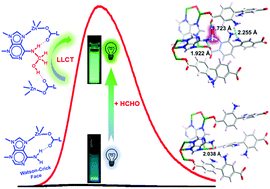Ultrasensitive and highly selective detection of formaldehyde via an adenine-based biological metal–organic framework†
Abstract
Formaldehyde poses a carcinogenic risk to human beings, yet it would be difficult to accurately quantify by spectroscopic methods if other volatile organic compounds were present. Herein, we report a robust adenine-based BioMOF (JNU-100) constructed through a mixed-ligand strategy with BPDC-(NH2)2, an amine-functionalized dicarboxylate of intrinsically strong fluorescence, as the second ligand. JNU-100 exhibits an exceptional fluorescence “turn-on” exclusively for formaldehyde in aqueous solutions with a detection limit of 0.020 μM. In situ single-crystal X-ray diffraction studies reveal the hemiaminal formation on the Watson–Crick sites of adenines and the hemiaminal further stretching out to bridge over the neighboring BPDC-(NH2)2 through hydrogen bonding, which may suppress the nonradiative decay upon photoexcitation, resulting in restoration of the strong fluorescence of BPDC-(NH2)2. 13C solid-state NMR and isothermal titration calorimetry studies corroborate the hemiaminal formation on the Watson–Crick sites. Theoretical calculations confirm the fluorescence “turn-on” is originated from ligand-to-ligand charge transfer (LLCT) through the bridging hemiaminal. As a proof-of-concept, the rapid and visualizable response to formaldehyde is demonstrated by test strips. This work illustrates a successful design of MOF materials specifically for formaldehyde recognition without the interference of other volatile organic compounds by utilizing its reactivity on Watson–Crick sites and MOF compartmentalization.



 Please wait while we load your content...
Please wait while we load your content...